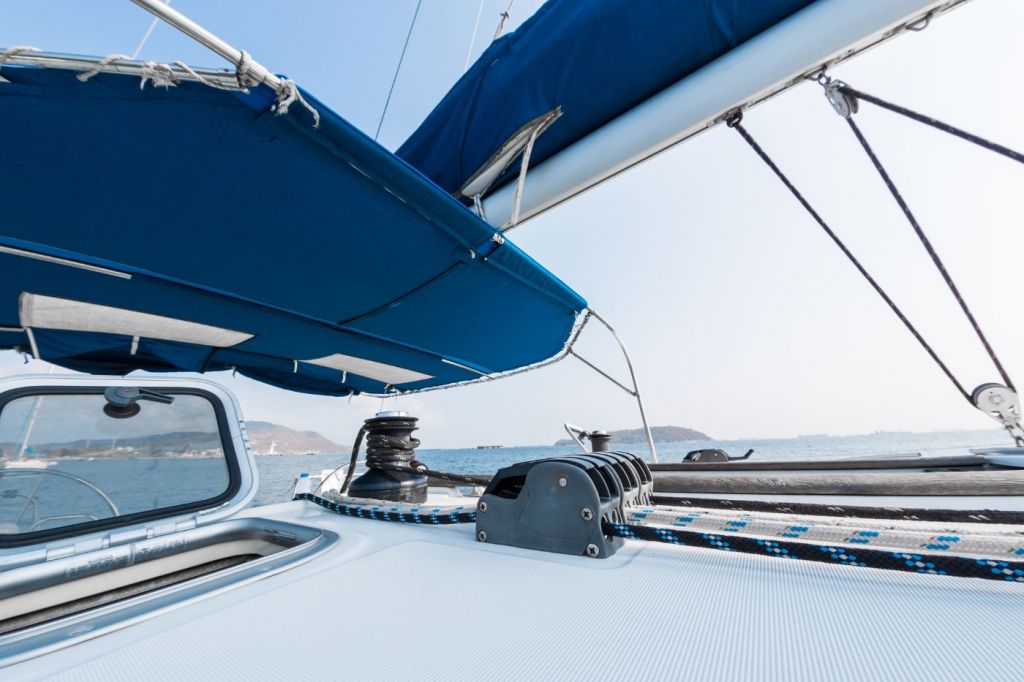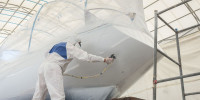How Much Does a Bimini Top Cost? (3 Examples)
There are lots of horror stories about long crossings without a good bimini. Staying out in the sun without protection can get quite annoying and eventually hazardous. Hats and rugs over your head are always a possibility, but if you want to be protected against the sun and rain and still have the ability to drive your boat from the cockpit, hassle-free, then a bimini will be on your list. Of course, the question is how much does it cost?
- A bimini top will cost you between $1000 and $3000 for an average sailboat.
- A hard top bimini will cost between $2000 and $6000 (twice as much).
- A DIY bimini kit costs around $200 - $300.
Not a cheap matter for sure, but as the cost largely depends on the materials used, so let's have a closer look to make sure you get as much as you can for your money.

Bimini Cost for Different Sizes and Materials
Long story short, for an average-sized boat, expect to pay $1000 - $3000 for a new bimini top.
Of course, this depends on size - a bimini for a 60 footer will easily cost you around $5000, while smaller boat owners sometimes make their own biminis using nothing but a DIY store and a few YouTube tutorials, as the structures are less complicated, resulting in $100 costs overall.
But the latter is really all the way at the bottom of the spectrum.
Then there are various materials. If you go for longevity and use a high-quality material that resists saltwater and sun rays well, you will pay more than for simpler sheets.
And finally, you got the tubing. Chances are that unless your boat is very old or you got into an accident, you will only be replacing the sheets. But if not, expect to pay hundreds of dollars more.
And it goes up from there. It won't be unrealistic to expect to pay twice the amounts quoted once you start adding little upgrades, windows, premium coatings, and all that jazz.
So just as is the case with our article about the cost of dodgers, this one too will list some cheaper alternatives.
How To Get a Bimini Top Cheaply
And just as is the case with dodgers, for biminis too, self make kits exist. You will be happy to hear that you can get a bimini kit for literally one-tenth of the price. Yes, $200 - $300 bimini top kits are plentiful.
One example of a well-known kit is SealSkinCovers. Their bimini kits aren't expensive and you can get them in all sizes. Check out their bimini kit here (SealSkinCovers.com).
If you are surprised, or if you have read our dodger cost article, where the kits are much more expensive, consider that the structure of a bimini top is way less complicated than that of a dodger.
If we take the vertical 'walls' out of the equation, we end up with a relatively simple flat roof shape, an angle of which is achieved simply by bending the material, not necessarily elaborate stitching.
This is good news for assemblage as well. Putting together a dodger from a DIY kit can be a daunting task. The time and know-how necessary for a DIY route can be enough to steer one away from it, even though it means a significant financial saving.
But with bimini tops being considerably simpler, the DIY way is much more accessible. And if you do end up making some measuring or stitching errors, they impact the functionality less than is the case with dodgers.
Check out the cheap and well-built bimini kit on SealSkinCovers here.
How To Save Money On a Bimini Top
Not to disappoint you from the onset, but unfortunately, it doesn't pay off to penny-pinch when it comes to biminis. Though you can get a custom one done for $500, chances are you will need to replace it much sooner than its $2000 counterpart.
Biminis belong to the group of boating bits that are at the forefront of the battle with elements. Just as sails or lines, biminis have to withstand quite a bit of abuse.
Salt, wind, heat, and sun, conditions often encountered when sailing, aren't fabric friendly. Sure, if you need a bimini for a river pontoon boat used to ride around Central Europe on sunny Sunday afternoons while being garaged off-season, which is pretty much half of a year, it's a different story. But that's not likely the scenario you are facing.
If you don't mind a more frequent replacement schedule, simply because you don't want to spend a lot of money at once, go for a brand such as Sunbrella. They often use acrylic weaves that do the job fine for a reasonable price.
But if you don't mind going premium, having your bimini top last much longer, Marchem fabrics or Topgun are the brands you want.
The higher prices here don't stem from elitism. Think of it as clothes. There the material choice and the subsequent price is also quite closely reflected in durability.
And last but not least, take good care of your bimini top. Cover it when it isn't being used, maintain it, repair small rips sooner, rather than later and when folding it down and putting it up, do it with care so you don't cause unnecessary wear and tear.
Also, when the bimini is folded, use the straps to hold it in place so that it does not flap around in the wind too much. The amount of wear caused by that thing alone is significant.
Hardtop Options
As you have probably seen, there are also hardtop biminis. These can be made of various plastics, metals, woods, or basically whatever you think of - if you make it yourself.
The durability is of course a big plus. A solid hardtop bimini can last you as long as your boat does.
A popular reason for building hardtop biminis is the possibilities a fixed structure holds. Oftentimes you see these hardtops fitted with lights, for instance, making the nighttime on deck time much more convenient.
Also, solar panels can be put on hardtops, which would otherwise be an eyesore.
Not mentioning the enlarged deck space, since hardtops tend to be sturdy enough to stand on. But beware of the boom. It is very likely to go quite close over the bimini.
As far as cons go, well, the design of hardtops is hated by many. Especially the aftermarket solutions tend not to go hand in hand with the boat's design, resulting in quite appalling structures.
Of course, the inability to take the top down and enjoy the open cockpit goes away, which can be an issue for many.
Then there is the matter of higher windage. Maneuvering in tight places in high winds can become much more painful.
And last but not least, there is the higher center of gravity.
Having a bimini like that done will cost you 1.5 - 2 times as much as what you would pay for a classical one. But it is likely a one-time expense and if you are the DIY type, they are much easier to make yourself, since their architecture isn't really that complicated.
What Is a Bimini Top Exactly?
A Bimini top is the sort of a roof over a sailboat's cockpit, most usually made from cloth, that is fixed to a foldable metal structure. It is not the front 'windshield' bit - that is called a dodger - we are talking about the roof part only.
Sometimes the cloth extends down a bit, creating walls of sorts, though these are mostly removable, optional parts. The bimini is usually not see-through, except for either holes or see-through parts just above the helm area so that you can see the sails or the wind direction gauge on the top of the mast.
And since they usually extend all the way back, they have holes for the backstays to be run through them.
Some biminis connect to the dodger directly, so paired with the aforementioned walls, create a full tent.
And some biminis aren't made of cloth at all and instead come in the 'hardtop' variant.
Just as is the case with dodgers, biminis are folded and put up constantly, they have to withstand quite a bit of wind and weather, so even if you just bought yourself a brand new boat, you will have to think about replacing or fixing your bimini sooner and later. So let's see how much they go for.
Conclusion
Biminis are important. Easy as that. Certainly for longer passages, but weekend sailors welcome them too. They can make your stay on deck much more pleasant and protect you from the elements.
They do cost quite a bit and they do need to be replaced every now and then.
But if you make yourself a hardtop, much of the bimini-related pain goes away.
Did you find the answer to your specific question?
👍 3 👎 0


Leave a comment